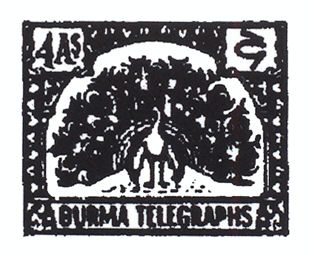| Up a level | |||||||||
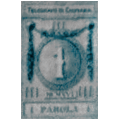 |
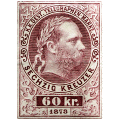 |
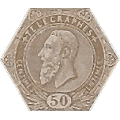 |
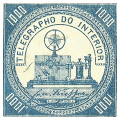 |
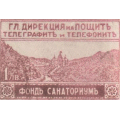 |
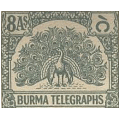 |
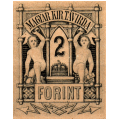 |
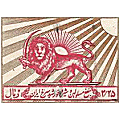 |
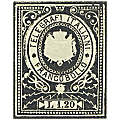 |
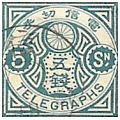 |
| Albania | Austria | Belgium | Brazil | Bulgaria | Burma | Hungary | Iran | Italy | Japan |
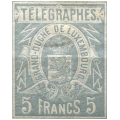 |
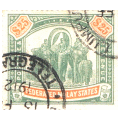 |
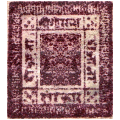 |
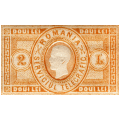 |
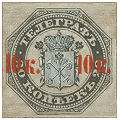 |
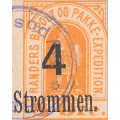 |
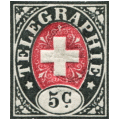 |
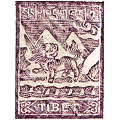 |
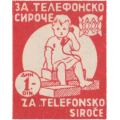 |
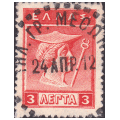 |
| Luxembourg | Malaya | Nepal | Rumania | Russia | Scandinavia | Switzerland | Tibet | Yugoslavia | Miscellaneous |
I have had to re-number these due to a missing set, though leaving references to the original designations. I have now brought the prices up to date and added currency selection. The new designations have 'RH' numbers (Revised Hiscocks) to avoid confusion. A catalogue of these has been recommended to me entitled: A Catalogue of Telegraph and Revenue Stamps for Burma and Myanmar ( 1895-1997 - by Alan Meech and Gerald Davis : ISBN 0-96817997-0-3 ) This seems to be hard to find, but I have been sent a photocopy of most of Part 5, that on the telegraph stamps. CheckList Setup |
BURMA.
My notes:
I have added images of some used stamps, added pricing, and also added a new set, the first Official stamp series.
The catalogue by Alan Meech and Gerald Davis referenced above has an interesting snippet on page 52 that says (referring to an illustration):
"Letter from Burmese wartime government in exile at Simla to the Burma Office in
London, asking for royal approval of the design of proposed telegraph stamps. This
initiative led to the publication of the first Burma telegraph stamps in 1946.
Note that no 4 annas denomination telegraph stamp (a photograph of which
appears on the document) has ever been seen."
1946 (1 October ?) Offset-Lithographed by the Indian Government Security Press, Nasik Road on white wove paper.
Watermark multiple elephant's heads sideways. Perf. 14. Sheets of 320 (16 x 20).
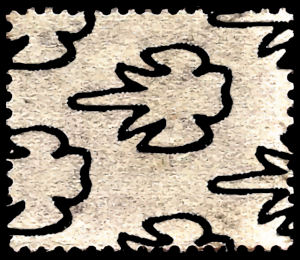 |
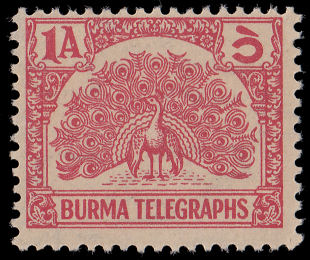 |
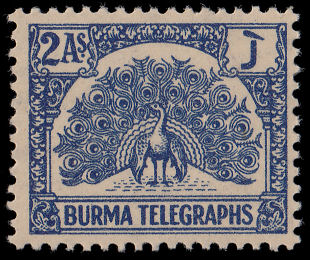 |
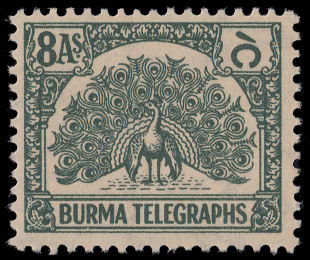 |
| Watermark as viewed from the back. | Type 1 (RH1) 1A - Mint | Type 1 (RH2) 2As - Mint | Type 1 (RH3) 8As - Mint |
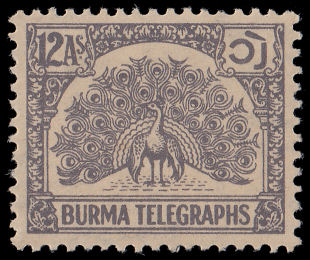 |
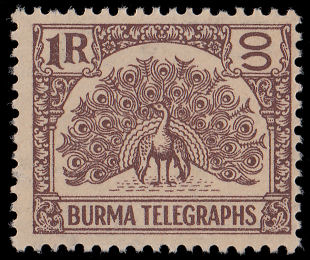 |
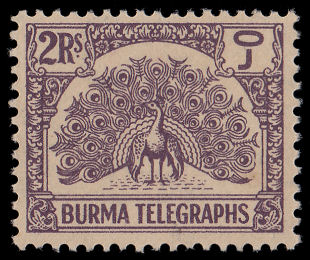 |
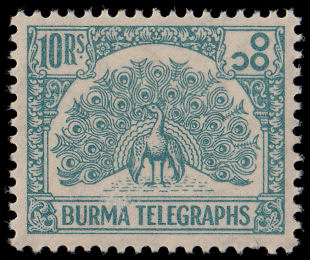 |
| Type 1 (RH4) 12As - Mint | Type 1 (RH5) 1R - Mint | Type 1 (RH6) 2Rs - Mint | Type 1 (RH7) 10Rs - Mint |
 |
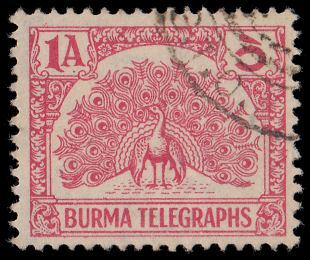 |
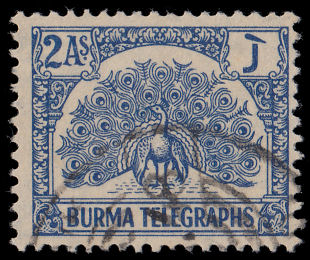 |
| Watermark as viewed from the back. | Type 1 (RH1) 1A - Used | Type 1 (RH2) 2As - Used |
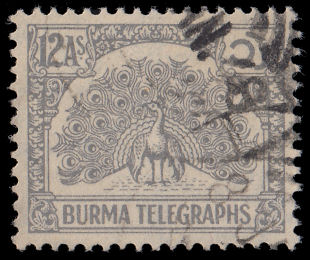 |
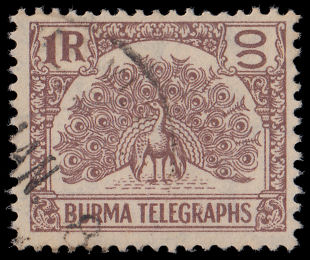 |
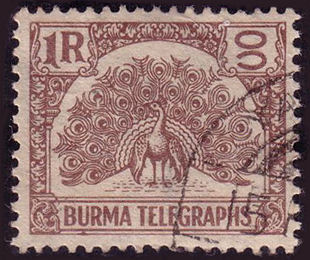 |
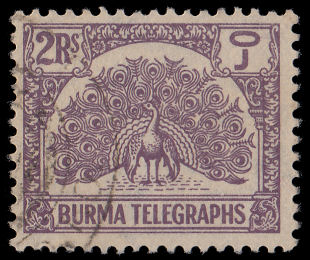 |
| Type 1 (RH4) 12As - Used | Type 1 (RH5) 1R - Used | Type 1 (RH5) 1R - Used from RL | Type 1 (RH6) 2Rs - Used |
Five of the set (RH1, RH2, RH4, RH5 and RH6) used (Jan 1948) with G.T.O. Indian style cancel. These are normally considered not to exist.
The procedure was for the customer to fill in the telegraph form and hand it to a clerk behind the counter. The clerk would then count the words, calculate the charge,
and collect payment from the customer. The clerk would then affix the stamps to the form, cancel them and hand a small receipt to the customer.
The telegraph form was kept in official records for 1 year and then destroyed.
Perhaps these were Cancelled by Favour, though such things normally have nice neat cancels. Alternatively, someone broke the rules.
All but the second 1R acquired from Dr Joe on ebay.
The colour of the 12As stamp is described variously in different catalogues as Bluish grey, Purple-brown, Brown-purple or greyish purple.
Certainly many of the overprinted ones have little colour in them. The truth seems to be that the early 12As stamps were a more lavender shade than later stamps.
Additionally toning of the paper may add more red to the shade.
Les Bottomley says that the first issue "was rather fuzzy to say the least and very bland to look at"
and that later in the same year there was a new clearer/sharper issue. His illustrations show some comparisons:
The top two are his illustrations, with the left stamp having a poorer quality print. The shades are different too, though the left stamp is a little toned.
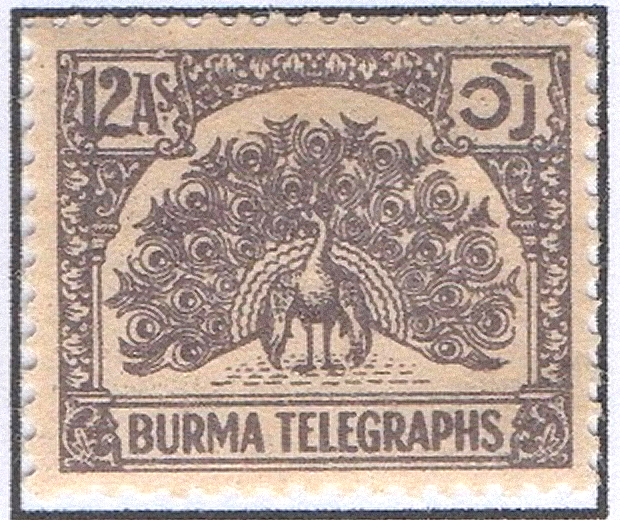
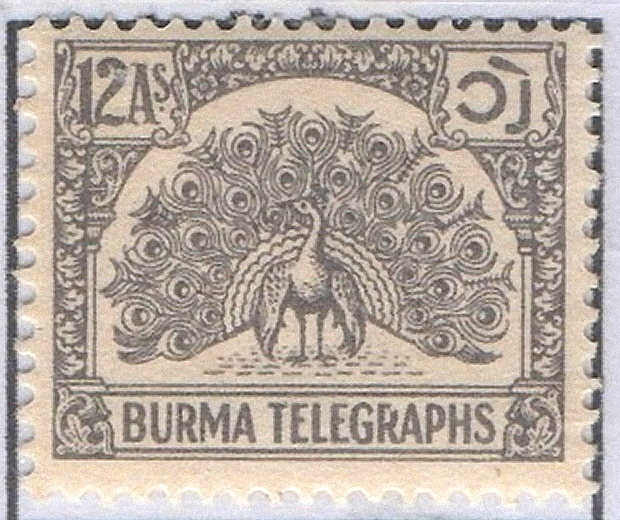
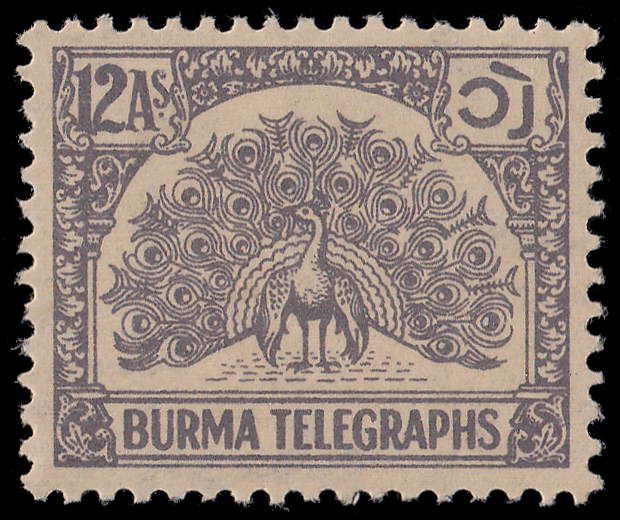
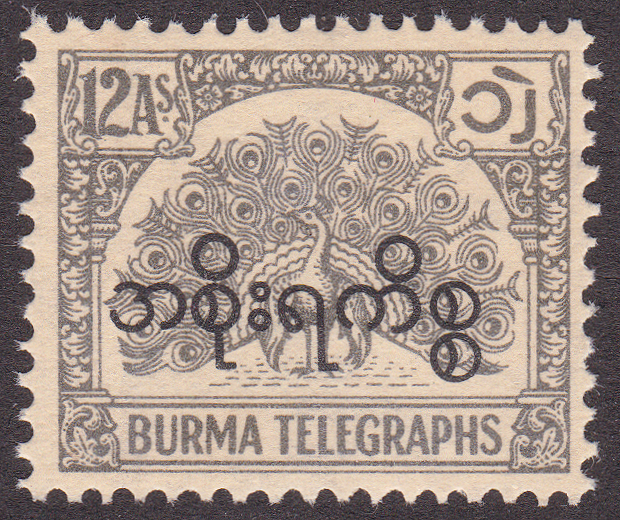
The bottom two are mine. The quality of printing is good on both but they have little colour. It is possible that the poor quality print described for the early examples was
due to poor quality, unsurfaced paper absorbing ink, with better quality of paper used later. These are reported to have been printed by Nasik Security Printing in India,
Supposedly by offset-litho. Perhaps the early ones were actually on a plain litho. machine. Anyone know more about this ?
A 4As value was also prepared for use, but not issued. An image can be seen above.
1954 New design and new currency. Other details as above.
 |
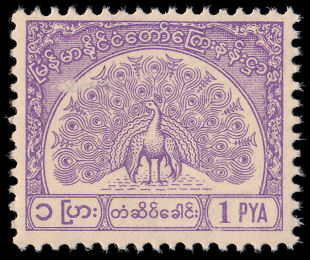 |
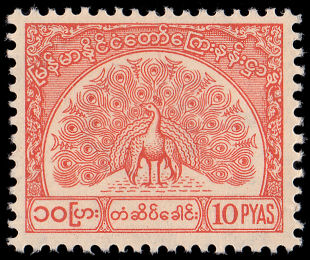 |
| Watermark as viewed from the back. | Type 2 (RH8) 1Pya | Type 2 (RH10) 10Pyas |
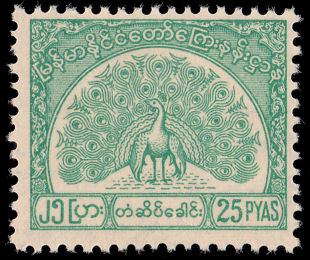 |
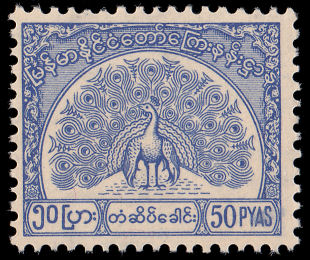 |
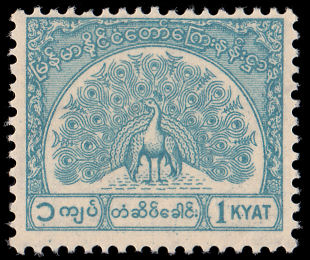 |
| Type 2 (RH12) 25Pyas | Type 2 (RH13) 50Pyas | Type 2 (RH15) 1Kyat |
| New # | Type. | was | Description | Mint | Used |
|---|---|---|---|---|---|
| RH8 | 2 | H8 | 1p reddish lilac | 2.50 | - |
| RH9 | 2 | H9 | 6p ? | - | - |
| RH10 | 2 | H10 | 10p red-orange | 2.50 | - |
| RH11 | 2 | H11 | 13p ? | - | - |
| RH12 | 2 | H12 | 25p turquoise green | 3.00 | - |
| RH13 | 2 | H13 | 50p dull ultramarine | 3.50 | - |
| RH14 | 2 | H14 | 75p sepia | - | - |
| RH15 | 2 | H15 | 1K greenish blue | 6.00 | - |
| RH16 | 2 | H16 | 2K rose-carmine | - | - |
| RH17 | 2 | H17 | 10K deep olive green | - | - |
Hiscocks added the following 2 notes:
| Note 1. Only those for which colours are given have been seen The remainder are however listed in a contemporary official document of the Burmese Telegraphy Office. |
| Note 2. Telegraph stamps were discontinued and withdrawn on 1 October 1961. |
My note:
RH14, RH16 and RH17 are reported to have been seen by Lim Peng Hong (Rangoon) in 'The Burmese Peacock' (Vol.5,No.3, Fall 1983).
The same report includes the un-overprinted version of RH33, implying that RH9 is actually a 5p value, not 6p as thought.
I know of no reports of the existence of RH9 as a 6p value, or RH11. Can anyone provide scans of any of the missing ones ?
I have no scans of those stamps though.
OFFICIAL STAMPS .
1948? As Nos. 1 to 7 but overprinted with the word 'Service' in Burmese script in black.
WARNING: There are stamps with forged Official overprints (see below).
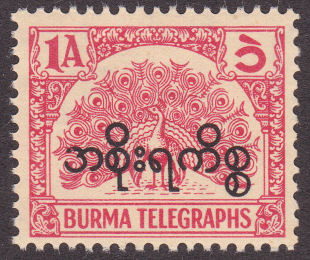 |
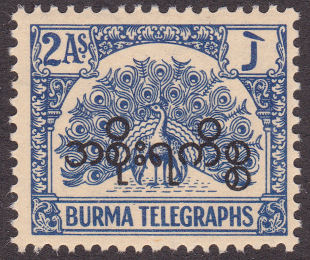 |
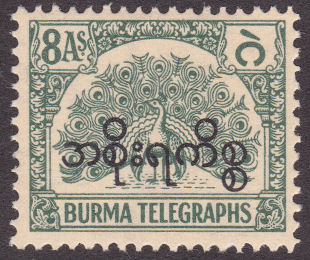 |
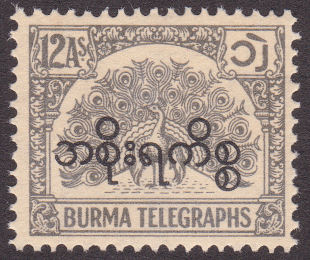 |
| Type 3 1A (RH18) | Type 3 2A (RH19) | Type 3 8A (RH20) | Type 3 12A (RH21) |
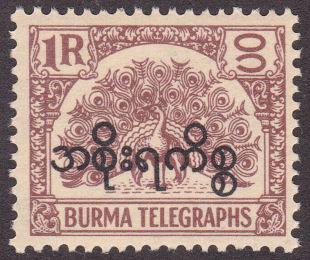 |
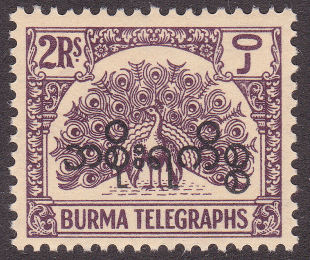 |
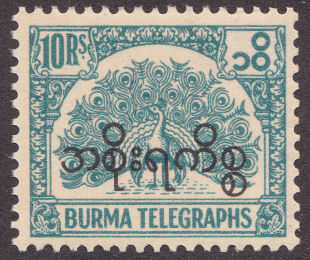 |
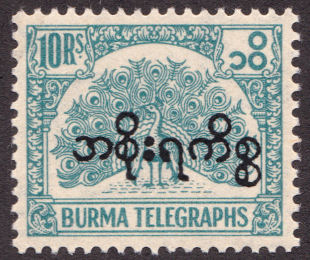 |
| Type 3 1R (RH22) | Type 3 2R (RH23) | Type 3 10R (RH24) | Example with a forged overprint for comparison. |
I have (so far) only seen this forged overprint on this set, but it may also exist on the following two sets.
1946 is sometimes given as the date for these, but as Lim Peng Hong (Rangoon) quite reasonably points out in
'The Burmese Peacock' (Vol.5,No.3, Fall 1983), prior to independence from Britain(1948), the English language would have been used for the overprint.
I would like to add that the lack of the head of King George VI in the design is also unusual, begging an explanation.
it is more like a 1948 design, the first postal issue of which was in English.
| New # | Type. | was | Description | Mint | Used |
|---|---|---|---|---|---|
| RH18 | 3 | - | 1 Anna carmine-red | 8.00 | - |
| RH19 | 3 | - | 2 Annas deep dull blue | 8.00 | - |
| RH20 | 3 | - | 8 Annas grey green | 8.00 | - |
| RH21 | 3 | - | 12 Annas bluish grey | 10.00 | - |
| RH22 | 3 | - | 1 Rupee brown | 10.00 | - |
| RH23 | 3 | - | 2 Rupees deep dull purple | 12.00 | - |
| RH24 | 3 | - | 10 Rupees turquoise-blue | 15.00 | - |
1953 As above but additionally overprinted bilingually with values in new currency in black.
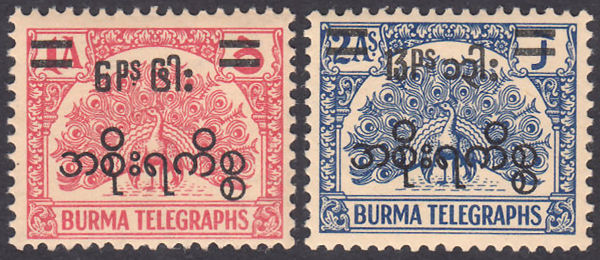 |
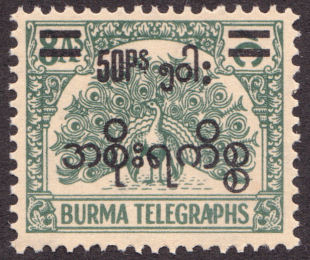 |
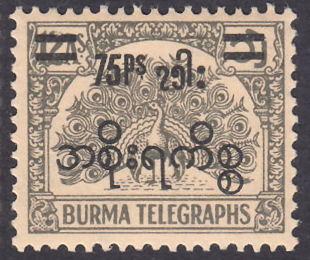 |
|
| Type 4 (RH25) | Type 4 (RH26) | Type 4 (RH27) | Type 4 (RH28) |
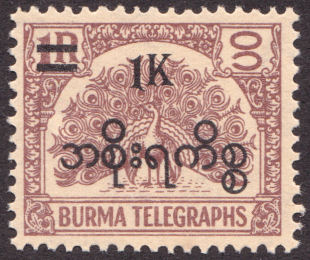 |
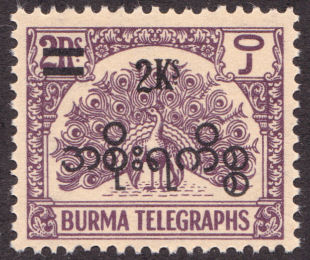 |
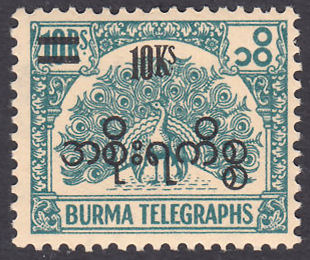 |
| Type 5 (RH29) | Type 5 (RH30) | Type 5 (RH31) |
| New # | Type. | was | Description | Mint | Used |
|---|---|---|---|---|---|
| RH25 | 4 | H18 | 6p on 1 Anna carmine-red | 2.00 | - |
| RH26 | 4 | H19 | 13p on 2 Annas deep dull blue | 2.50 | - |
| RH27 | 4 | H20 | 50p on 8 Annas grey green | 8.00 | - |
| RH28 | 4 | H21 | 75p on 12 Annas bluish grey | 3.00 | - |
| RH29 | 5 | H22 | 1K on 1 Rupee brown | 15.00 | - |
| RH30 | 5 | H23 | 2K on 2 Rupees deep dull purple | 20.00 | - |
| RH31 | 5 | H24 | 10K on 10 Rupees turquoise-blue | 10.00 | - |
1954 As Nos. 8 to 17 but overprinted 'Service' in Burmese script in black.
 |
| Type 6 (RH32 - RH35) |
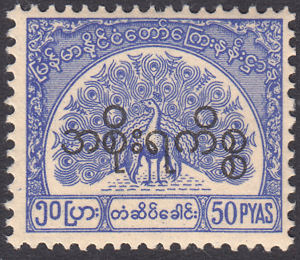 |
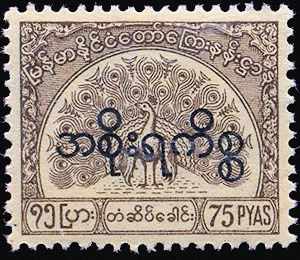 |
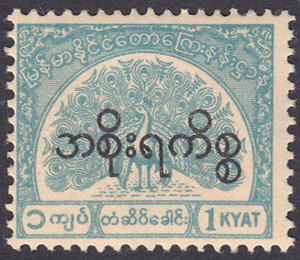 |
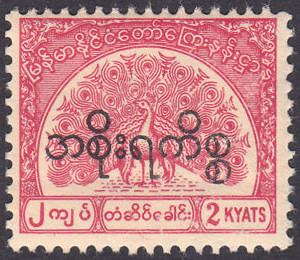 |
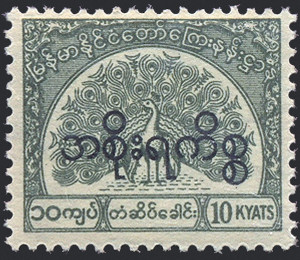 |
| Type 6 (RH36) | Type 6 (RH37) Courtesy of Rolf Lamprecht. |
Type 6 (RH38) | Type 6 (RH39) | Type 6 (RH40) Courtesy of Rolf Lamprecht. |
Some apparently used examples.
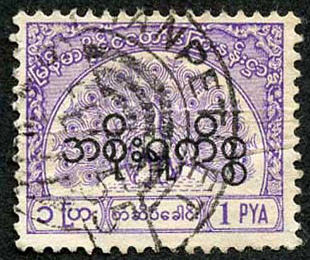 |
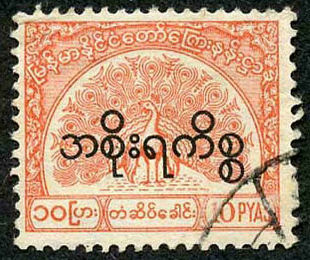 |
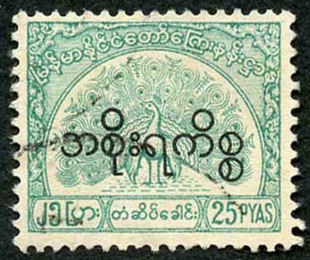 |
| RH32 1Pya used - courtesy of Mark Bloxham. | RH34 10Pya used - courtesy of Mark Bloxham. | RH35 25Pya used - courtesy of Mark Bloxham. |
The 1Pya stamp is dated 8 February 1955, Ranpetlet is in the Chin Hills, North Burma/Myanmar, at an altitude of 2,286 m.
| New # | Type. | was | Description | Mint | Used |
|---|---|---|---|---|---|
| RH32 | 6 | H25 | 1p reddish lilac | 2.00 | - |
| RH33 | 6 | H26 | 5p reddish purple | 2.00 | - |
| RH34 | 6 | H27 | 10p orange | 2.50 | - |
| RH35 | 6 | H28 | 25p turquoise green | 2.50 | - |
| RH36 | 6 | H29 | 50p dull ultramarine | 3.00 | - |
| RH37 | 6 | H30 | 75p sepia | 5.00 | - |
| RH38 | 6 | H31 | 1K greenish blue | 3.50 | - |
| RH39 | 6 | H32 | 2K rose-carmine | 4.00 | - |
| RH40 | 6 | H33 | 10K deep olive green | 10.00 | - |
Hiscocks added the following note:
| Note. The Burmese Government listing of around 1960 seems to imply that a 5p value was issued only for service use, and a 6p value only for public use. |
Notice that I have not seen the 5p, 75p 2K and 10K without this Official overprint. If they exist, they are probably rare or errors.
I would like to hear from anyone that has examples of those values without the overprint.
STATIONERY.
As far as Stationery is concerned, before independece, Burma appears to have used forms of India.
I would welcome examples of later forms.
Comments, criticisms, information or suggestions are always welcome.

Please include the word 'Telegraphs' in the subject.
Last updated 15th. January 2024
©Copyright Steve Panting 2012/13/14/15/16/17/18/19/20/21/22/23/24 except where stated.
Permission is hereby granted to copy material for which the copyright is owned by myself, on condition that any data is not altered and this website is given credit.
